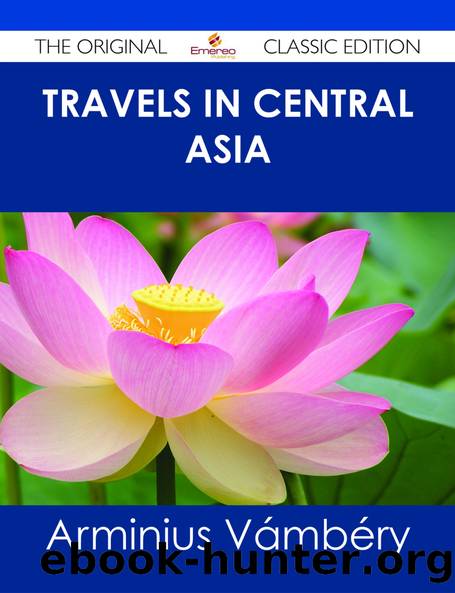Travels in Central Asia by Ármin Vámbéry

Author:Ármin Vámbéry [Vámbéry, Ármin]
Language: eng
Format: epub
ISBN: 9788186505021
Google: JxZyPgAACAAJ
Publisher: Bhavana Books & Prints
Published: 1996-01-15T16:07:19+00:00
[Ersari Turkomans]
As Kerki is a frontier fortress, and is, so to say, the key of Bokhara on the side of Herat, let us describe it more in detail. As I before said, the fortifications are divided into two parts. The citadel on the right bank of the river is very small, and is defended by only four cannon, and guarded in time of peace by a few soldiers. The fortress itself, on the left bank, consists first of the castle built upon the hill, encircled by three walls, and having, as I heard, twelve cannon of iron and six of brass: the walls are of earth and tolerably strong, five feet broad and twelve feet high. The town, which is spread round the fortress, consists of 150 houses, three mosques, a small bazaar, and karavanserai: it is also defended by a good wall and deep ditch. The inhabitants are Ãzbegs and Turkomans, employed a little in trade, but more in agriculture. Near the walls of the city is the tomb of the famous Imam Kerkhi, the author of many commentaries. The province of Kerki extends from the vicinity of Chardjuy to the ford Hadji Salih (falsely called Hojasalu), on the bank of the Oxus, so far as the canals of {231} the said river run. This country is inhabited by the Ersari Turkomans, who pay tribute to the Emir only to secure themselves from hostilities on the part of the other tribes. In earlier and different times the sovereign of Bokhara had other possessions on the further side of the Oxus, but he was deprived of them by the victorious Dost Mohammed Khan, and now has nothing remaining there except Chardjuy and Kerki.
I heard, to my great regret, that Mollah Zeman, the chief of the karavan, proceeding from Bokhara to Herat, would not arrive for eight or ten days. I therefore considered it advisable to pass the interval rather in journeys amongst the Turkomans than in Kerki. I went with Mollah Ishak to the tribes Kizil Ayak and Hasan-Menekli, amongst whom there were Mollahs who had seen me at Bokhara with some of my friends. The Ersari Turkomans, who only migrated hither from Manghishlak 200 years ago, and have not recognised the supremacy of Bokhara except during the last forty years, have retained very little of the national characteristics of the Turkomans. They may be styled only semi-nomads, the greater part cultivating the land, and the remainder, still exclusively pastoral, having lost with their savage character all the primitive virtues of their kindred tribe. The exertions of Bokhara, in favour of civilisation, have stripped them at once of their sword and their integrity, giving them in exchange the Koran and hypocrisy. Never shall I forget the scenes that I witnessed as a guest in the house of one of the most considerable Ishans of these Turkomans. Khalfa Niyaz had inherited from his father sanctity, knowledge, and rank. He had a Tekkie (monastery), {232} where a limited number of students were instructed à la Bokhara.
Download
This site does not store any files on its server. We only index and link to content provided by other sites. Please contact the content providers to delete copyright contents if any and email us, we'll remove relevant links or contents immediately.
| Africa | Americas |
| Arctic & Antarctica | Asia |
| Australia & Oceania | Europe |
| Middle East | Russia |
| United States | World |
| Ancient Civilizations | Military |
| Historical Study & Educational Resources |
The Sympathizer by Viet Thanh Nguyen(4100)
The Rape of Nanking by Iris Chang(4027)
World without end by Ken Follett(3348)
Ants Among Elephants by Sujatha Gidla(3282)
Blood and Sand by Alex Von Tunzelmann(3061)
Japanese Design by Patricia J. Graham(3006)
City of Djinns: a year in Delhi by William Dalrymple(2438)
Foreign Devils on the Silk Road: The Search for the Lost Treasures of Central Asia by Peter Hopkirk(2392)
Inglorious Empire by Shashi Tharoor(2349)
The Queen of Nothing by Holly Black(2328)
India's Ancient Past by R.S. Sharma(2307)
In Order to Live: A North Korean Girl's Journey to Freedom by Yeonmi Park(2305)
Tokyo by Rob Goss(2295)
India's biggest cover-up by Dhar Anuj(2251)
Tokyo Geek's Guide: Manga, Anime, Gaming, Cosplay, Toys, Idols & More - The Ultimate Guide to Japan's Otaku Culture by Simone Gianni(2245)
The Great Game: On Secret Service in High Asia by Peter Hopkirk(2232)
Goodbye Madame Butterfly(2165)
Batik by Rudolf Smend(2010)
Living Silence in Burma by Christina Fink(1990)
